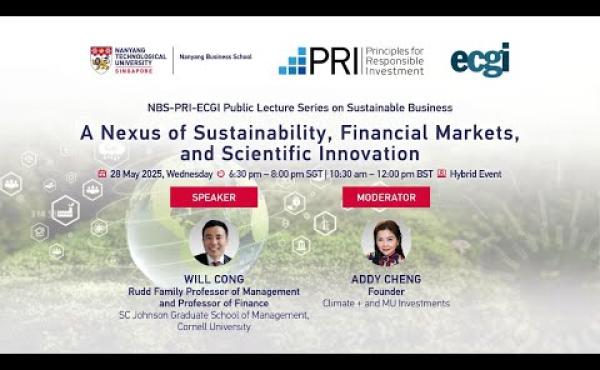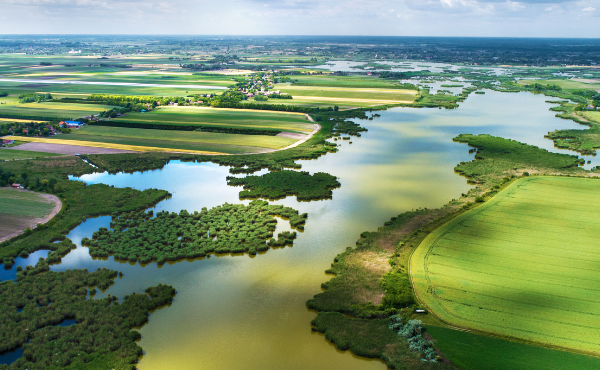
The ECGI blog is kindly supported by

The Unseen Ripple Effects of Sustainability Policy
A review of the lecture “A nexus of sustainability, financial markets, and scientific innovation” by Professor William Cong 28th May 2025.
When we talk about climate policy or biodiversity conservation, our minds tend to leap toward the obvious: sea levels rising, carbon taxes, protected forests, and endangered species. But Professor William Cong’s recent lecture at Nanyang Business School – part of the NBS-PRI-ECGI Public Lecture Series – made a compelling case for why we need to not only develop comprehensive measurements of these direct impacts, but also look beyond them to consider their broader socioeconomic implications. The lecture explored how sustainability interventions, however well-intentioned, can have complex and sometimes surprising ramifications in financial markets and scientific innovation. As Professor Cong put it, “There are unanticipated, sometimes fortuitous, sometimes unintentional, consequences of the global sustainability issues or conservation policies.”
At the heart of the presentation were three empirical studies that probed what might be called the “economic externalities” — unanticipated implications of climate change or unintended consequences of policies designed to combat biodiversity loss. Together, they offered a multidimensional view of sustainability, one that underscores the need for more integrated thinking in policy design and evaluation.
Heatwaves, Housing, and Hidden Inequality
The first study examined how extreme heat affects housing transactions in China. On the surface, it might seem unlikely that a few hot days could distort a high-stakes transaction like buying a home. But Cong and his co-authors Addoum and Zhou found that an extra day above 35°C during the transaction week can increase prices by over 0.5%, amounting to a $1,858 wealth transfer from buyer to seller — a statistically and economically significant figure.
Why? Buyers under heat stress become less effective at negotiating, inspecting, or gathering information. But the implications go beyond mispricing. These shifts are not distributed evenly. Young and male buyers, as well as those in the northern regions and higher-end markets, are more affected. This dynamic also narrows the gender gap in housing investment returns, raising complex questions about who benefits—and who bears the cost—when climate meets cognition.
Biodiversity and Public Financing
The second study centered on China’s Green Shield Action (GSA), a sweeping initiative to enforce preservation rules in national nature reserves. Cong together with his co-authors Chen, Chen, Gao and Ponticelli revealed that the policy led to real biodiversity improvements, but also increased local governments’ general borrowing costs — by about 24 basis points, translating to an estimated $40 billion in additional interest payments between 2018 and 2021.
This happened, Cong explained, because “this is a top-down policy that’s strictly enforced, but [local governments] had little financial support.” Municipalities bore most of the cost of implementing the GSA, yet capital markets responded to the fiscal strain rather than the environmental gains. Investors, at least in this setting, were more attuned to short-term financial risks than to long-term ecological improvements.
This disconnect between financial “value” and environmental “values” exposes a structural weakness in sustainability finance. Policy design need to consider these trade-offs. Blended finance, adequate sustainability disclosure and education tools, and more careful allocation of central government funding could help spread costs more equitably among investors who have varying preferences for short-term returns and long-term impact of their investments, as well as improve the efficacy of intervention policies.
Conservation by Design—or by Chance?
The final study offered a more hopeful twist. In this paper Cong co-authored with Chen, Gao, Karolyi and Wang, they found that a seasonal fishing ban on the Yangtze River—meant to protect threatened fish populations—ended up turbocharging scientific research in China. In the years following the ban, fish-related research funding, publications, citations, and even public engagement rose dramatically.
Importantly, this was not due to targets of the policy itself or heightened attention from researchers following the policy. Rather, the ban improved access to biological research materials, enabling scientists to conduct experiments and pursue new lines of inquiry. The policy wasn’t designed to boost research—it just did, by restoring a resource base for scientific discovery.
The implication? Sustainability policies, even when not aimed at innovation, can act as catalysts for knowledge creation. Recognizing and planning for such positive externalities could reshape how we think about conservation not only as a moral imperative, but as a strategic investment in future innovation.
Strategic Implications: More Than a Green Checkbox
Across the three studies, one message was clear: sustainability and related policies often have broader and unexpected consequences. They interact with financial markets, reshape behavior, and influence institutions beyond their original scope.
For policymakers, this means thinking beyond environmental outcomes alone. As seen with China’s Green Shield Action, conservation efforts can strain local government finances if fiscal capacity isn’t accounted for—raising borrowing costs and creating unintended financial pressures. Targeted financing tools and better policy design can help align ecological goals with fiscal realities.
For investors, the findings highlight that markets tend to price short-term risk, not long-term environmental gains. Closing this gap will require improved disclosure, longer-term instruments, and better-aligned incentives.
And for researchers, sustainability is not just a theme—it’s a structural factor that shapes economic systems. As the Yangtze River case showed, even policies not aimed at research can catalyze scientific progress when conditions allow.
Professor Cong’s lecture made a compelling case for more integrated thinking. Economists, scientists, and policymakers must work together to navigate the ripple effects of sustainability—because understanding the full impact of these interventions is essential to making them effective.
-----------------------------------
This lecture is part of the NBS-PRI-ECGI Public Lecture Series, a global initiative on sustainable business. Nanyang Business School (NBS), in collaboration with the Principles for Responsible Investment (PRI) and the European Corporate Governance Institute (ECGI), launched this series to foster knowledge exchange between academics, practitioners, and policymakers. As part of this initiative, leading academics present cutting-edge research on sustainability topics, while industry experts moderate discussions, providing real-world insights and facilitating dialogue between research and practice.







